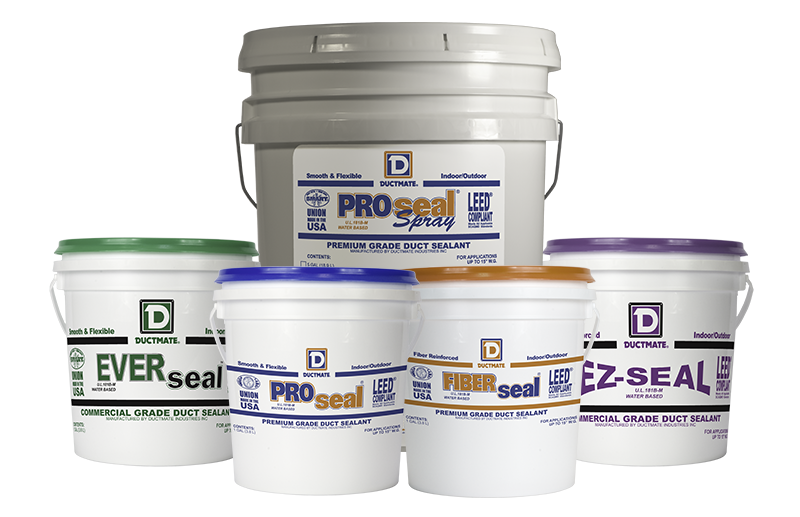Technical Data Sheets – From Confusion to Clarity
Technical Data Sheets (TDS) related to water-based duct sealants can be just as intimidating as synonyms for the first word in the acronym, erudite or abstruse. These data sheets are provided to give specifics about the performance of each product for better product selection. However, the list of standards (NFPA 90A and 90B or ASTM C794), complex acronyms (TVOC Emissions CDPH Standard Method v1.1), and scientific units (cps or PLI) could leave the average person confused and allowing price to be the leading factor during selection. The truth is that engineers provide this information because they are truly dedicated to the product they worked very hard to develop, and would like to share all of the technical information possible explaining the positive attributes of the sealant itself. Ductmate understands that this information is not the easiest to grasp, and therefore, this article aims to describe a few key test specifications that may not be so obvious to understand at first glance.
Solid Content is one of the most misunderstood specifications most duct sealant manufacturers report on their technical data sheets. In most cases, more is better (unless you are playing golf). Solid content is a lot like your ideal golf game. Water-based duct sealants start out with a polymer that is the backbone of any formulation. These polymers are between 50-55% solids (the other 45-50% is water). To get the solid content to reach “typical” levels of 60-80% for the average sealant, 100% solid fillers are added. These fillers will reduce the water content in the formulation leading to quicker dry times and reduced cost, but most fillers provide little performance characteristics and will eventually lead to negative returns when added at an elevated level.
For the sealant to maintain other critical performance characteristics like flexibility and adhesion, there must be enough polymer in the formulation to hold all of the filler together. Envision a ball pit or a sandbox. In either case, it would be very difficult to cover the entire surface area of the particles without reducing the amount of those particles present. Ideally, a combination of large particles and smaller particles lends to better packing of the fillers.
This allows for the dried sealant to be a strong, flexible coating that will hold up to the harsh conditions a duct system may go through during its lifetime (vibrations, expansion/contraction as air begins to fill the duct, or transferring between cold and hot conditions). Sealants that contain too much filler, or only one size of filler, could result in cracking and poor adhesion. Just think, if there is not enough polymer to surround all of the filler present, how will there be enough to bind to the steel or hold all of the particles together during movement? Flexibility and adhesion are perhaps the two most important characteristics of any duct sealant. These characteristics can be accidentally ignored when choosing a duct sealant based on a high solid content.
Tricks of the Statistics: Solid Content can be linked to performance characteristics like Flexibility and Adhesion, but they are also typically proportional to other common specifications on a technical data sheet. For instance, when the solid content is in the 70-80% range, the density (how many lbs. are in a one-gallon pail) is also typically higher. This could lead to higher shipping costs. Viscosity is also typically affected at high solid content levels. The higher the solid content, the thicker the sealant tends to be. If the product is too thick, the sealant will be harder to brush. In this case, excess sealant is often used driving up the cost of the job.
Below is a table breaking down some key technical data and how each relates directly to a Ductmate Water-Based Sealant. We hope this chart can help end users select which sealant is right for their own use. For example, if you want a product with great adhesion to steel, is easily spreadable, LEED compliant, and matches the color of steel = EVERseal. If you want a product that adheres very well to multiple substrates, is great for outdoor use, can be used in high pressure systems, and is LEED compliant = PROseal. If you want a premium product that is also sprayable = PROseal Spray.
| Ductmate Sealants | Adhesion to Metal | Adhesion to Flexible Duct Connectors | Flexibility | Outdoor Applications | Brush Drag | Sag Resistance | <15" Water Gauge | LEED Compliant | Fiber Texture | Sprayable | Color Match to Galvanized Steel |
| PROseal | ••• | ••• | ••• | ••• | •• | ••• | ••• | Yes | No | No | • |
| FIBERseal | ••• | ••• | ••• | ••• | •• | ••• | ••• | Yes | Yes | No | • |
| EVERseal | ••• | •• | ••• | •• | ••• | •• | •• | Yes | No | No | •• |
| EZseal | ••• | •• | ••• | •• | ••• | •• | •• | Yes | Yes | No | •• |
| PROseal Spray | ••• | ••• | ••• | ••• | n/a | • | ••• | Yes | No | Yes | • |
••• = Excellent
•• = Above Average
• = Standard
For more information, please visit our Water-Based Sealant page or to download Technical Data Sheets for any of our products, please browse our Technical Resources page.
